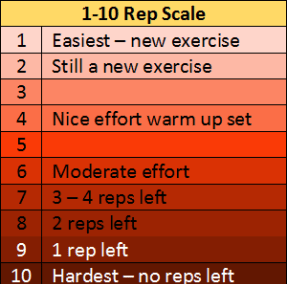How Much Weight?
“How much weight should I use?” I get this question all the time. Especially when I write the workouts my clients will be doing on their own. My clients learn very quickly I will never give them a specific weight, I may give them some suggestions but never the actual weight.
Why? Simple, I learned a long time ago I have very good diligent clients who follow directions really well. If I asked them to do 3 sets of 12 reps using a 30 pound dumbbell they would do it. Regardless of how it feels or the training day they are having.
I can honestly say a lot of thought goes into answering the “how much weight question”.
So many different variables come in to play. Training age, goals, volume and intensity, the specific exercise, sets and rep ranges just to name a few.
Most of the time I have my clients use my 1-10 Rep Scale to help them figure out weights. I will explain it in more detail a little later.
Training Age
Let’s first start with training age as a guideline for weight selection. Training age could refer to one of two things. The actual age of the lifter or the level of experience of the lifter. In both cases the younger the age the lighter the weight, maybe even just body weight.
Exercise Selection
Probably the next biggest variable for me is the exercise itself. Are you doing the exercise for the first time? Is it fairly new or have you done it hundreds of times? (Correctly I might add). Use a light weight when doing new exercises, until the exercise is mastered. Using the correct muscles is also important. Once I can say yes to both questions I begin to add weight or make the progression more difficult if it is a body weight exercise.
Training Goals
Next variable I look at is training goals. Obviously the client wanting to gain strength will lift heavier than the person looking to improve endurance. Gaining strength requires you to move a lot more weight. While improving endurance requires a higher rep range with lighter to no weight. Even if the goal is strength I still have the client start light in weight until the exercise is mastered.
1 Rep Max
You may be familiar with the term 1 RM or 1 rep max. Often times the 1 RM is used to determine the weight that should be used for any given exercise. It is technically the greatest amount of weight that can be lifted one time for an exercise.
A 1 RM can be calculated in one of two ways. First, by doing a maximal lift. And secondly by using a 1RM calculator. A generic program may tell you to lift 75% of your 1 RM. If you don’t know your 1 RM how are you supposed to figure out the 75%?
In my opinion maximal tests are not safe and the 1 RM calculators are not extremely accurate, so I rarely use them. And since I start clients at a very low weight they are not needed. (Remember you start low until you have mastered the exercise).
1-10 Rep Scale

Instead, I use a 1-10 Rep Scale. This helps my clients know when it is time to move the weight up or progress the exercise to a more difficult level.
For example, let’s say you are doing a set of squats for 8 reps. And the training intensity can be high because you have mastered the exercise. Ask yourself at the end of the set what was the difficulty level on a scale of 1-10. 1 being the easiest and 10 being the hardest? You can use the chart to help you better understand the system.
If you were at a 10 there should not be any reps left in your tank. Maybe you were only able to complete 7 of the 8 reps, this would equal 9 on the scale. Let’s say you were shooting for an intensity of 10 on the scale. But you had another 3 – 4 reps in you. Your weight is too light.
Progressing Weight
Once my clients reach a training intensity of 8 and sometimes 9 on the scale. It is time to move up in weight or to the next progression in the exercise. They need to reach this for all their sets.
If the exercise is new you should still be training at a level 1-2. Move up the scale when the exercise is mastered.
It isn’t unusual to have clients doing 4-5 exercises in their routine and have them all over the place on the scale. Think about it every time you throw in a new exercise you need to start the process over at a lower level.
Training this way serves two purposes, injuries and over-training issues are at a minimum and hitting the dreaded plateau does not happen as often.
The next time you train try using my scale and see if it helps. Good Luck!
Stay Motivated,

